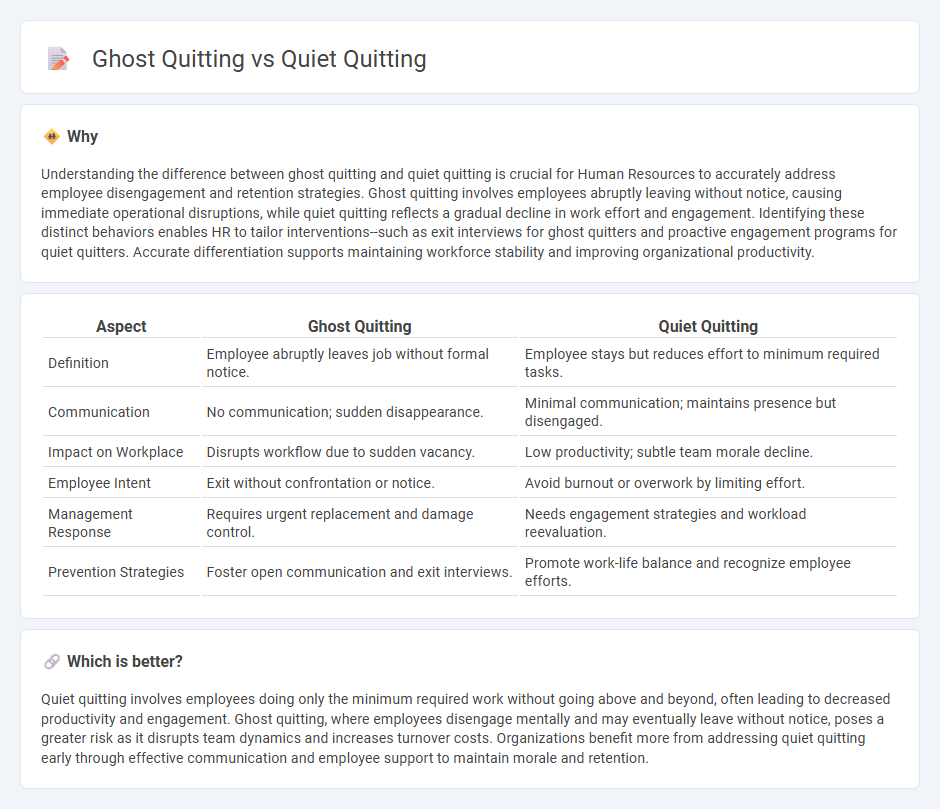
Ghost quitting involves employees abruptly leaving their jobs without notice, causing sudden disruptions in the workflow and team dynamics. Quiet quitting refers to employees staying in their roles but disengaging by doing only the minimum required tasks, which can lead to decreased productivity and morale. Explore the differences and implications of ghost quitting versus quiet quitting to better understand workforce retention strategies.
Why it is important
Understanding the difference between ghost quitting and quiet quitting is crucial for Human Resources to accurately address employee disengagement and retention strategies. Ghost quitting involves employees abruptly leaving without notice, causing immediate operational disruptions, while quiet quitting reflects a gradual decline in work effort and engagement. Identifying these distinct behaviors enables HR to tailor interventions--such as exit interviews for ghost quitters and proactive engagement programs for quiet quitters. Accurate differentiation supports maintaining workforce stability and improving organizational productivity.
Comparison Table
| Aspect | Ghost Quitting | Quiet Quitting |
|---|---|---|
| Definition | Employee abruptly leaves job without formal notice. | Employee stays but reduces effort to minimum required tasks. |
| Communication | No communication; sudden disappearance. | Minimal communication; maintains presence but disengaged. |
| Impact on Workplace | Disrupts workflow due to sudden vacancy. | Low productivity; subtle team morale decline. |
| Employee Intent | Exit without confrontation or notice. | Avoid burnout or overwork by limiting effort. |
| Management Response | Requires urgent replacement and damage control. | Needs engagement strategies and workload reevaluation. |
| Prevention Strategies | Foster open communication and exit interviews. | Promote work-life balance and recognize employee efforts. |
Which is better?
Quiet quitting involves employees doing only the minimum required work without going above and beyond, often leading to decreased productivity and engagement. Ghost quitting, where employees disengage mentally and may eventually leave without notice, poses a greater risk as it disrupts team dynamics and increases turnover costs. Organizations benefit more from addressing quiet quitting early through effective communication and employee support to maintain morale and retention.
Connection
Ghost quitting and quiet quitting both reflect employee disengagement where workers reduce their commitment and effort without explicit resignation. Ghost quitting involves employees disappearing or becoming unreachable, causing workforce unpredictability, while quiet quitting entails fulfilling only basic job requirements to avoid burnout. These behaviors signal underlying issues in workplace culture and management, emphasizing the need for proactive employee engagement strategies and open communication channels.
Key Terms
Employee Engagement
Quiet quitting describes employees doing only the minimum required tasks without extra effort or emotional commitment, impacting overall productivity and company morale. Ghost quitting occurs when employees disengage internally while physically present or suddenly leave without notice, creating disruption in workflow and team dynamics. Explore strategies to enhance employee engagement and prevent both quiet and ghost quitting for a healthier workplace.
Performance Management
Quiet quitting involves employees reducing effort and engagement without formally resigning, impacting productivity and team dynamics in performance management. Ghost quitting occurs when employees disengage mentally and physically while remaining employed, often leading to unaddressed performance gaps and lowering organizational efficiency. Explore strategies to effectively identify and manage quiet and ghost quitting for improved workforce performance.
Communication
Quiet quitting involves employees doing the bare minimum required, often refraining from extra communication or engagement, while ghost quitting refers to employees abruptly disappearing from their roles without notice or explanation. Effective communication is crucial to managing both behaviors, as it helps identify dissatisfaction early, fosters transparency, and supports timely interventions for retention. Explore strategies to enhance workplace communication and prevent quiet or ghost quitting to maintain a productive and committed team.
Source and External Links
What Is Quiet Quitting and Can It Be Prevented? - Paychex - Quiet quitting refers to employees gradually disengaging from their roles--reducing work output, avoiding social interactions, and showing little interest in projects--often before eventually leaving their jobs.
Quiet Quitting: A Proper Guide to a Very Real Trend - Personio - Quiet quitting is when employees do just enough to keep their jobs but refuse to take on extra tasks, volunteer for projects, or work overtime, reflecting a shift away from going above and beyond for their employer.
When Quiet Quitting Is Worse Than the Real Thing - Quiet quitting describes employees who fulfill their core duties but opt out of extra responsibilities and become less psychologically invested in their work, avoiding activities like staying late or attending non-mandatory meetings.
 dowidth.com
dowidth.com